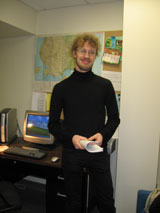

![]()
::: postdoc fellowships
::: senior fellowships
::: resident fellowships
::: associateships
![]()
being here
::: visiting
::: the last donut
::: photo album
::: center home >> people >> visiting fellows, 2006-07 >> persson |
||||
| Johannes Persson Johannes is interested in explanation, metaphysics of causation, and philosophy of risk. Or, rather, maybe his main interest is in mechanisms? That concept has always an important role in his approaches to all three fields.
At the Center he will study some major contributions to theories of mechanisms and causation that people from Johannes is from Johannes is fond of fishing and would be very happy if someone were to show him how a Northern pike or muskie is caught in
June 2009 J. Persson. (in press). Semmelweis’s methodology from the modern stand-point: intervention studies and causal ontology. Studies in History and Philosophy of Biological and Biomedical Sciences. August 2010 Part of this year Johannes has been on parental leave. When at work he has been thinking about mechanisms, the philosophy of risk, and his new interest: the philosophy of interdisciplinarity. He is arranging a workshop on the latter topic in October 11-13—Peter Machamer has promisd to come—and if you are interested in participating please feel free to email him. Recent publications: Persson, J. (2010). Activity-based accounts of mechanism and the threat of polygenic effects. Erkenntnis 72(1): 135-149. DOI: 10.1007/s10670-009-9195-5 open access Sahlin, N.-E., Wallin, A. and Persson, J. (2010). Decision Science: From Ramsey to Dual Process Theories. Synthese 172(1): 129-143. DOI: 10.1007/s11229-009-9472-5 Persson, J. (2010). Mechanisms: Are activities up to the job? EPSA Epistemology and Methodology of Science: Launch of the European Philosophy of Science Association. (Red.) Suárez, M., Dorato, M., and Rédei, M. Springer: pp: 201-209. DOI: 10.1007/978-90-481-3263-8_17 Persson, J. (2010). Misconceptions of positivism and five unnecessary science theoretic mistakes they bring in their train. International Journal of Nursing Studies 47(5): 651-661.DOI: 10.1016/j.ijnurstu.2009.12.009 Vareman, N and Persson, J. (2010). Why separate risk assessors and risk managers? Further external values affecting the risk assessor qua risk assessor. Journal of Risk Research 13(5): 687-. DOI: 10.1080/13669871003660759 Sahlin, N.-E., Persson, J. and Vareman, N. (2010, in press). Unruhe und Ungewissheit – Stem Cells and Risks. Hermerén, G. and Hug, K. (Eds.). Translational Stem Cell Research: Issues Beyond the Debate on the Moral Status of the Human Embryo. Springer. |
||||
